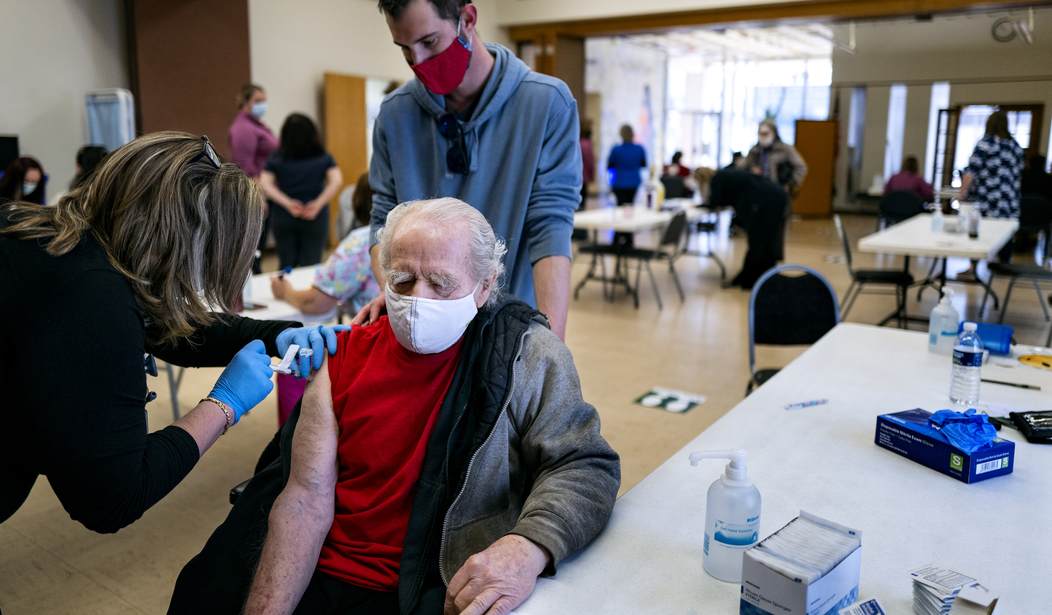Let's start with the astoundingly great news: The vaccines work, and they're spectacular. We've known this for quite some time, of course, with thorough trials producing exceptionally strong results -- which have stood up among a much wider population in nearly-fully-vaxxed Israel. Cases in that country have plummeted by a staggering and heartening 98 percent since a peak in January. Here in the United States, it's crucial to cut through the alarmist nonsense of the media and certain vaccine truthers, and look at how unbelievably, miraculously well the vaccines have been working. Every time you read a headline about a stray "breakthrough" infection (someone who contracted COVID after getting immunized), or see a misleading, hand-wringing piece about various strains, force your brain to 'zoom out' and look at the big picture. It's beautiful:
CDC identifies only 5,800 Covid-19 infections after the final vaccine, out of more than 66 million. And those who got it had mild cases. https://t.co/gvBu6s1mlQ
— Eliza Collins (@elizacollins1) April 15, 2021
Based on CDC data, more than 66 million Americans have been fully vaccinated (the total number has now swelled by 10 million). Among those people, just a few thousand experienced 'breakthrough' infections. And only a few dozen have died from the virus. Part of the human psyche cannot help but fixate on the microscopic percentage of vaccine 'failure' (remember, we've always known that like all vaccines, these are not 100 percent perfect), but the overall results are beyond outstanding. This is how the pandemic ends, period. Here's the math:
CDC has identified a small cohort of approximately 5,800 cases among more than 66 million Americans who have completed a full course of vaccination. These so-called breakthrough cases represent 0.008% of the fully vaccinated population.
— Pradheep J. Shanker (@Neoavatara) April 15, 2021
Phrasing it another way, "the odds of post-vax infection are approximately 1-in-11,000." And almost all of those unlucky 1-in-1,000 breakthrough cases are mild. The vaccines work very, very, very well. And yet, within the first few sentences of the Journal story, readers are treated to this absolutely wrong take-away:
Recommended
Officials said such cases are in line with expectations because the approved vaccines in the U.S. are highly effective but not 100% foolproof. They are a reminder that even vaccinated people are at risk and should continue to take precautions such as masking and social distancing in many circumstances.
No, no, no. The lesson of a 0.008 percent breakthrough case rate, with a lopsided number of those cases being mild, is not that "even vaccinated people are still at risk" and should still wear masks and socially distance. The lesson is the opposite. Vaccinated people are safe and can resume their normal lives. It is almost enraging how top-level public health officials and many in the media continue to insist on upside-down messaging. It's harmful, especially among the millions of Americans who aren't in the 'vaccine enthusiastic' category. Relatedly, one of the reasons I've been so critical of the FDA's (now-extended) 'pause' on the overwhelmingly safe and effective Johnson & Johnson vaccine is that such a dramatic move, for such a statistically tiny reason (with no proven linkage to the potential issue) would heighten vaccine skepticism. Some people were touting this poll result as a refutation of that concern, but that's not the case, in my view. This is a White House official:
NEW POLL: The J&J pause makes people *more confident* in vaccines, not less.
— Ben Wakana (@benwakana46) April 14, 2021
M-O-R-E C-O-N-F-I-D-E-N-T pic.twitter.com/bqe6bTBwiR
This seems plausibly encouraging, but it's actually a specious point. Fully 43 percent of respondents say they're less confident in the COVID vaccines because of the J&J pause, or are not sure. It's a safe bet that nearly everyone represented in the green bar were already vaccine-positive (and/or vaccinated) people. The key moving forward is convincing vaccine-skeptical people to get their shots, a population that is almost certainly overrepresented in the red and gray bars. The very real fear here is that people who weren't already sold on vaccines are less likely to warm to the idea due to the pause, or could even slide in the opposite direction. And at least on the J&J vaccine, that's exactly what's happening, as was entirely predictable based on Europe's AstraZeneca debacle in March:
The CDC recommendation to pause Johnson & Johnson vaccine use causes public confidence in the vaccine to sink 15pts
— YouGov America (@YouGovAmerica) April 15, 2021
Perceptions before CDC announcement
Safe - 52%
Unsafe - 26%
Perceptions after CDC announcement
Safe - 37% (-15)
Unsafe - 39% (+13)https://t.co/iHXCHRY6Xu pic.twitter.com/952PdGSFFf
This could partially rebound if any when J&J is given the all-clear, which could take weeks. But real damage has been done, in the form of an eye-popping 32-point shift. J&J is now underwater on the safety question, directly because the federal government decided to pause all of its shots nationwide over a possible 1-in-1,000,000 side effect that has only impacted half-a-dozen women within a certain age bracket. Madness. Dr. Marc Siegel ripped the FDA's decision on my radio show yesterday:
.@DrMarcSiegel on the J&J vaccine pause: “Really inappropriate... over-vigilant... tragic.” Says FDA should have issued a warning but kept shots going. https://t.co/OCkCxNlevv
— Guy Benson (@guypbenson) April 14, 2021
Why not go with the warning option? Or at worst, a targeted pause?
Dr. Jha has been a beacon of clarity on the vaccines. His J&J take:
— Derek Thompson (@DKThomp) April 15, 2021
“Given most cases of vaccine-related CVST appears in women, ACIP should have recommended continuing pause for women 18-49 but resuming for everyone else. Keeping vaccine paused for everyone makes little sense” https://t.co/jvExtpoqD8
Also, it's not true that logistically speaking, J&J doses can just be easily swapped out for two-shot mRNA alternatives. Some needle-phobic people might have decided they could handle a one-time dose, but would balk at two. More importantly, the J&J doses are much easier to store and transport, and therefore are crucial to serving certain communities, including in under-developed parts of the world. Plus, any delays in the rate of injections could literally cost lives. And are the mRNA vaccines (Pfizer and Moderna) risk-free on blood clots? I hesitate to share this because of how much irrational hysteria there already is out there, but...
Study shows similar incidence of rare blood clots with Pfizer and AstraZeneca COVID vaccines https://t.co/JN7JZibAMc
— CBS News (@CBSNews) April 15, 2021
A study by researchers at Oxford University in England suggests the risks of experiencing dangerous, rare blood clots in the brain are far higher in those who catch the coronavirus than in those who get either the AstraZeneca vaccine, or the vaccines made by Pfizer and Moderna in the U.S. The research shows that the number of people who experience clots after getting the vaccines made by the American pharmaceutical giants appears very similar to the number who get the rare condition after a shot of the AstraZeneca drug, which was developed in conjunction with Oxford's vaccine institute. A key finding of the research, revealed Thursday as a "pre-print" study which has yet to be reviewed by other scientists, was that the risk of experiencing a blood clot in the brain was about 95 times higher for people who contract COVID-19 than in the general population.
The risks of not getting vaccinated massively overwhelm the possible "risks" of getting vaccinated, even within the narrow realm of blood clots. Before you go, re-read the fantastic overall news about the vaccines above, then consider these comparisons:
Via a friend, for J&J perspective: pic.twitter.com/P81YPjaqb0
— Guy Benson (@guypbenson) April 14, 2021
I'm still somewhat in shock that the J&J pause was recommended in the first place, let alone extended.
























Join the conversation as a VIP Member